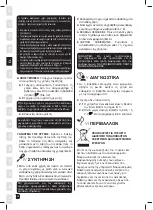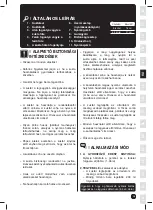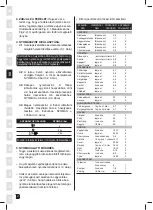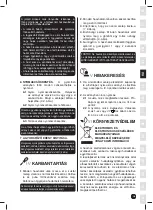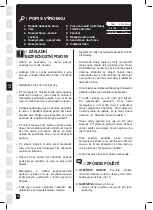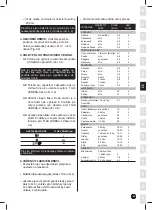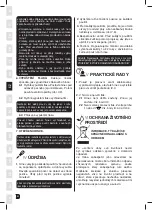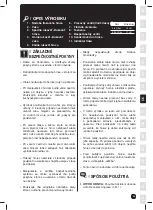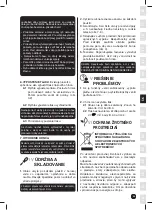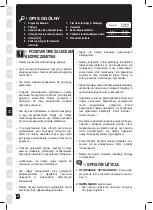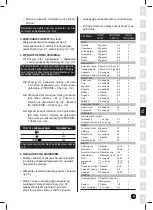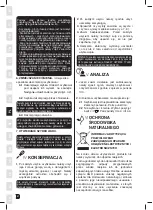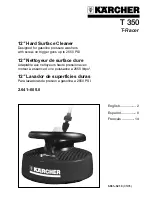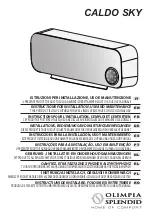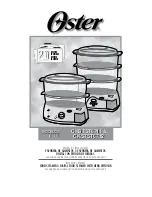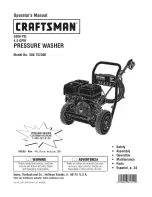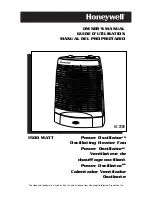
12
The times indicated are meant only as a guideline. You
should adjust them to suit your personal tastes, cooking
style and ingredients, etc.
» It is best to soak lentils, chickpeas and haricot beans
etc. before cooking.
» You do not need to defrost frozen pulses or small fi sh.
Increase cooking time by a few minutes when cooking
large fi sh and frozen meat.
» Frothy soups (e.g. pea soup, etc.) should be fi rst cooked
with the lid off. Before closing the lid remove the froth
with a skimmer.
» You do not need to worry about water evaporation as
only a very small amount of vapour actually escapes.
» Brown meat a little more than normal as the vapour
tends to lighten the colour. Cooking times will depend
on its thickness and quality.
» Clean fi sh well, squeeze a little lemon juice over the top
and season immediately before cooking.
6. DECOMPRESSION.
There are several ways
of reducing the pressure:
6.1
Quick decompression. Place the pressure
cooker under the extractor hood or take it
outside. Then turn the valve to (Fig.3.2).
6.2
Quick decompression by cooling.
Pour a little cold water over a corner of the lid until the
orange indicator drops. Never submerge the pressure
cooker in water, as this is very dangerous.
6.3
Natural decompression.
If you let the pressure cooker cool down in the position you
have cooked the food in, take this extra time into account
when calculating the cooking times.
7. OPENING THE PRESSURE COOKER.
Move
the open-close selector to the open position and
turn the lid handle to the right holding the body
handle in your left hand (fi g. 6).
1.
After each use, wash the pan with hot soapy
water and a soft cloth, rinse and dry. Take
special care with the inside of the lid.
Do not use wire sponges or abrasive products as these
could scratch the stainless steel coating.
2.
Clean the sealing gasket manually after each
use.
IV
MAINTENANCE
3.
Check that the vapour outlets are clean and
free from obstructions.
4.
Safety valve. Before each use, press the
sphere with a ballpoint pen to make sure it is
not obstructed.
5.
Gasket. We recommend that you replace the
gasket every 1 or 2 years, depending on the
frequency of use.
IMPORTANT: Do not adjust parts or attempt to assemble
them in any way other than that indicated. ALWAYS USE
ORIGINAL SPARE PARTS.
1.
If the operating valve is blocked, turn off the
heat, open the pressure cooker and clean the
operating valve as described in point IV.3.
2.
No pressure is building up inside the pressure
cooker:
2.1
The pressure cooker is not correctly clo-
sed. Close it again. See point III.3.
2.2
No pressure has been selected. Select po-
sition 1 or 2/P/
. See points III.4.3 and
III.4.4.
V
TROUBLESHOOTING
INFORMATION FOR THE
CORRECT DISPOSAL
OF ELECTRICAL AND
ELECTRONIC APPLIANCES
At the end of its working life, the product must not
be disposed of as urban waste.
It must be taken to a special local authority di-
fferentiated waste collection centre or to a dealer
providing this service. Disposing of a household
appliance separately avoids possible negative
consequences for the environment and health
deriving from inappropriate disposal and enables
the constituent materials to be recovered to ob-
tain signifi cant savings in energy and resources.
VI
ENVIRONMENT
ES
EL
NL
PT
HU
BG
CA
FR
CZ
RU
GL
EN
PL
SK
AR
EU

















